Related Research Articles
Aramaic is a language that originated among ancient Arameans, at the beginning of the 1st millennium BC, and later became one of the most prominent languages of the ancient Near East. During its three thousand years long history, Aramaic went through several stages of development. It has served as a language of public life and administration of ancient kingdoms and empires, and also as a language of divine worship and religious study. It subsequently branched into several Neo-Aramaic languages, that are still spoken in modern times.
Aram may refer to:
The Arameans were an ancient Semitic-speaking people in the Near East, first recorded in historical sources from the late 12th century BC. At the beginning of the 1st millennium BC, a number of Aramean states were established throughout the Levant and Upper Mesopotamia. Local Aramean kingdoms were subsequently conquered by the Neo-Assyrian Empire. During the period of Assyrian rule, policy of population displacement and relocation, that was applied throughout the Assyrian domains, also affected Arameans. As a result of wider dispersion of Aramean communities, speaking areal of Aramaic language was also widened, gradually gaining significance and eventually becoming the common language of public life and administration, particularly during the periods of Neo-Babylonian Empire (612–539), and later Achaemenid Empire (539–330). As a result of linguistic aramization, a wider Aramaic-speaking areal was created throughout the central regions of the Near East, exceeding the boundaries of Aramean ethnic communities. During the later Hellenistic and Roman periods, minor Aramean states emerged, most notable of them being the Kingdom of Osroene, centered in Edessa, the birthplace of Edessan Aramaic, that later came to be known as Syriac language.

Aram, also known as Aramea, is the homeland of the Arameans and a historical region mentioned in the Bible, covering much of the present-day Syria, including areas where the cities of Damascus and Aleppo now stand. At its height, Aram stretched from the Mount Lebanon range eastward across the Euphrates, including parts of the Khabur River valley in northwestern Mesopotamia on the border of modern Iraq. During the period from the 10th to the 8th centuries BCE, several Aramean states existed in the region. After the final conquest by the rising Neo-Assyrian Empire in the second half of the 8th century, and also during the later consecutive rules of the Neo-Babylonian Empire and the Achaemenid Empire, region of Aram was also known as Eber-Nari. During the Seleucid period, the term Syria was introduced as Hellenistic designation for this region, but the native name (Aram) persisted in use among Arameans, up to the Arab conquest in the 7th century CE.
Aram-Naharaim is the ancient land of the Arameans and biblical term for a region in Upper Mesopotamia along the elbow of the Euphrates River. It is mentioned five times in the Hebrew Bible or Old Testament. In Genesis, it is used somewhat interchangeably with the names Paddan Aram and Haran to denote the place where Abraham stayed briefly with his father Terah's family after leaving Ur of the Chaldees, while en route to Canaan, and the place from which later patriarchs obtained wives, rather than marry daughters of Canaan.
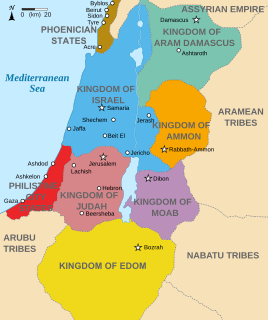
Aram-Damascus was an Aramean state around Damascus in Syria, from the late 12th century BC to 732 BC.
Hadadezer, son of Rehob, was king of Zobah, a Syrian (Aramaean) kingdom that may have been in the Beqaa valley of Lebanon, extended along the eastern side of the Anti-Lebanon Mountains reaching Hamath to the north. The kingdom of Zobah exercised power throughout southern Syria, and inevitably clashed with the expanding empire of Israel.

The states that are called Syro-Hittite, or Luwian-Aramean, were Luwian (Neo-Hittite) and Aramean regional polities of the Iron Age, situated in southeastern parts of modern Turkey and northwestern parts of modern Syria, known in ancient times as lands of Hatti and Aram. They arose following the collapse of the Hittite Empire in the 12th century BCE, and lasted until they were subdued by the Assyrian Empire in the 8th century BCE. They are grouped together by scholars, on the basis of several cultural criteria, that are recognized as similar and mutually shared between both societies, northern (Luwian) and southern (Aramean). Cultural exchange between those societies is seen as a specific regional phenomena, particularly in light of significant linguistic distinctions between two main regional languages, with Luwian belonging to Anatolian group of Indo-European languages, and Aramean belonging to Western Semitic group of Semitic languages. Several questions that are related to regional grouping of Luwian and Aramean states are viewed differently among scholars, including some views that are critical towards such grouping in general.
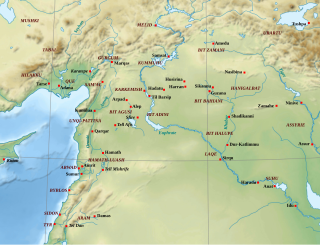
Bit Adini, a city or region of Syria, called sometimes Bit Adini in Assyrian sources, was an Aramaean state that existed as an independent kingdom during the 10th and 9th centuries BC, with its capital at Til Barsib. The city is considered one of the two chief states of the Aramean-held territories in the Euphrates along with Carchemish.

Syriac Christians are an ethnoreligious grouping of various ethnic communities of indigenous Semitic and often Neo-Aramaic-speaking Christian people of Iraq, Syria, Iran, Turkey, Lebanon, Jordan, Palestine, and Israel. Syriac Christians advocate different terms for ethnic self-designation. Syriac Christians from the Middle East are theologically and culturally closely related to, but should not be confused with, the Saint Thomas Christians from India, whose ties to Syriac Christians were the result of trade links and migration by Assyrian Christians from Mesopotamia and the Middle East mostly around the 9th century.
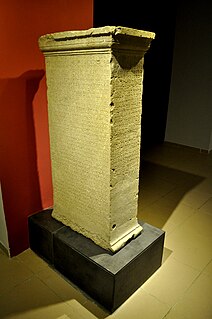
Imperial Aramaic is a linguistic term, coined by modern scholars in order to designate a specific historical variety of Aramaic language. The term is polysemic, with two distinctive meanings, wider (sociolinguistic) and narrower (dialectological). Some scholars are using the term as designation for a distinctive, socially prominent phase in the history of Aramaic language, that lasted from the middle of the 8th century BCE to the end of the 4th century BCE, and was marked by the use of Aramaic as a language of public life and administration in the late Neo-Assyrian Empire and its successor states, the Neo-Babylonian Empire and the Achaemenid Empire, also adding to that some later (Post-Imperial) uses, that persisted throughout the early Hellenistic period. Other scholars are using the term Imperial Aramaic in a more narrower sense, reduced only to the Achaemenid period, basing that reduction on several, strictly linguistic distinctions between the previous phase, and later Achaemenid phase. Since all of those phases can be semantically labeled as "imperial", some scholars opted for the use of more specific and unambiguous terms, like Neo-Assyrian Aramaic and Neo-Babylonian Aramaic, and Achaemenid Aramaic, thus avoiding the use of polysemic "imperial" label, and its primarily sociolinguistic implications. Similar issues occurred in relation to the uses of some alternative terms, like Official Aramaic or Standard Aramaic, that were also criticized as unspecific. All of those terms continue to be used differently among scholars.
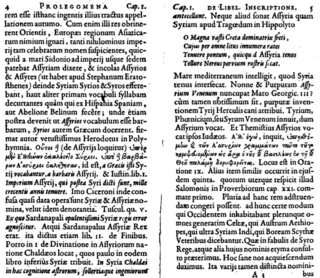
The name Syria is latinized from the Greek Συρία. In toponymic typology, term Syria is classified among choronyms. The origin and usage of the term has been the subject of interest, both among ancient writers and modern scholars. In early Greek usage, terms Συρία (Suría) and Ασσυρία (Assuría) were used almost interchangeably, but in the Roman Empire, terms Syria and Assyria came to be used as names for distinct geographical regions. "Syria" in the Roman period referred to the region of Syria, while Assyria (Asōristān) was part of the Sasanian Empire and only very briefly came under Roman control.
Aram is a son of Shem, according to the Table of Nations in Genesis 10 of the Hebrew Bible, and the father of Uz, Hul, Gether and Mash or Meshech. The Book of Chronicles lists Aram, Uz, Hul, Gether, and Meshech as descendants of Shem, although without stating explicitly that Aram is the father of the other four.
Aramean kings were kings of ancient Arameans, and rulers of various Aramean states that existed in western regions of the Ancient Near East during the 9th and 8th century BC, before being absorbed into the Neo-Assyrian Empire.
Old Aramaic refers to the earliest stage of the Aramaic language, known from the Aramaic inscriptions discovered since the 19th century.
Edward Lipiński, or Edouard Lipiński, is a Polish-Belgian Biblical scholar and Orientalist.
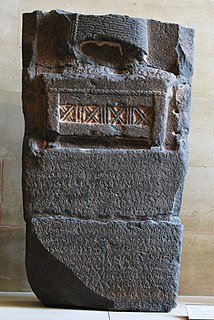
Zakkur was the ancient king of Hamath and Luhuti in Syria. He ruled around 785 BC. Most of the information about him comes from his basalt stele, known as the Stele of Zakkur.
The Haran Census is a group of clay tablets from Iron Age Syria, listing rural estates and their dependent peoples dated to the reign of Sargon II. Found in Nineveh, the census actually describes the area around Harran. The census shows that the population in the estates and nearby cities was predominantly Western Semitic, and had an average density of 5 persons per household. The census also provides the name of many smaller towns and the main residents of the time, and provides evidence that the Harran region was growing wheat, barley as well as vines, at the time.
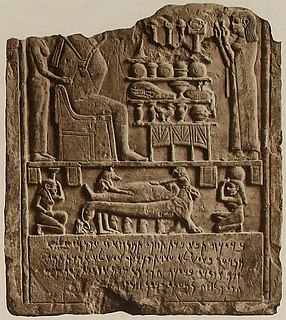
Aramaic studies are scientific studies of the Aramaic language and cultural history of Arameans. As a specific field within Semitic studies, Aramaic studies are closely related to similar disciplines, like Hebraic studies and Arabic studies.
References
- ↑ Lipiński 2000, p. 319.
- ↑ Sader 2010, p. 276.